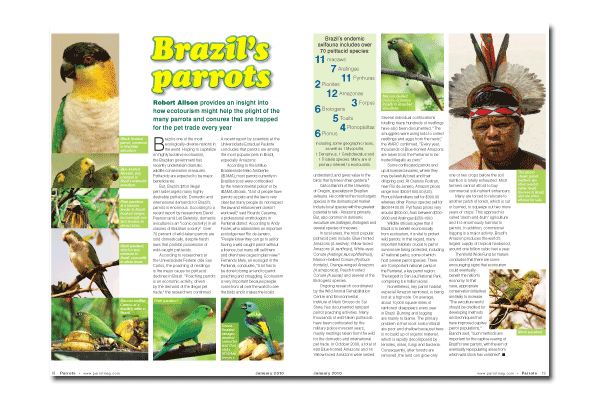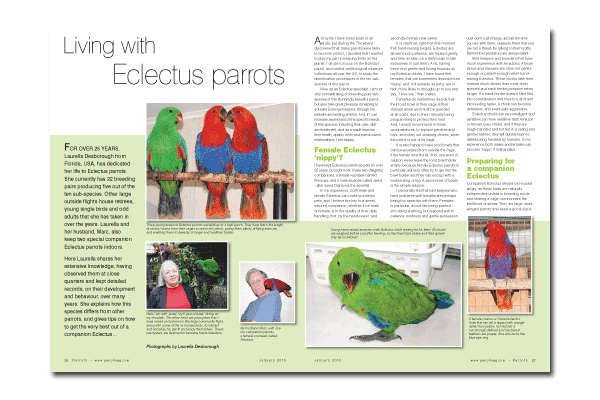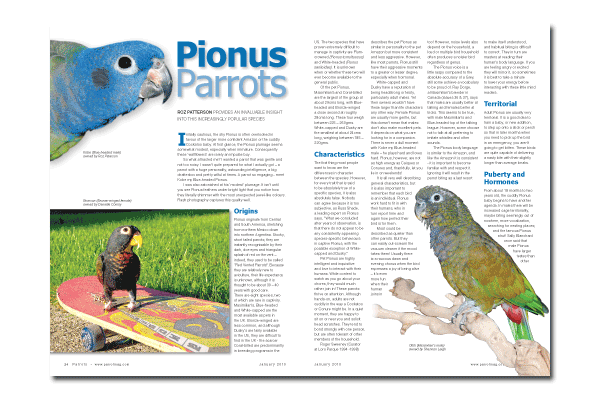
Trade patterns of wild African Grey parrots
By David Waugh, Loro Parque Fundación
In recent decades, a high level of capture and legal trade in wild African Grey Parrots (Psittacus erithacus) has occurred. A major exporting country has been Cameroon, with official statistics from 1981 to 2005 showing that it exported 367,166 individuals, with a yearly average of 15,299. From 1990 to 1996, it exported 48% of the African Grey Parrots of all countries in Africa. From 1993 to 2006, the official CITES (Convention on International Trade in Endangered Species of Fauna and Flora) annual export quota for this species from Cameroon had remained 12,000.
The high volume of trade and consistent exceeding of the quota led to concern over the impact on wild populations, and the Animals Committee of CITES called for scientific-based field surveys of wild populations, and the development of National and Regional Management Plans before resuming any trade, in line with its recommendation to institute a moratorium on exports of P. erithacus from Cameroon for two years from January 2007. Restrictive measures were also recommended for certain other exporting countries within the natural geographical range of the species.
Read more in the magazine…
Buy a copy now!
BACK

Brazil's parrots
Robert Alison provides an insight into how ecotourism might help the plight of the many parrots and conures that are trapped for the pet trade every year.
Brazil is one of the most ecologically-diverse nations in the world. Hoping to capitalize on highly lucrative ecotourism, the Brazilian government has recently undertaken dramatic wildlife conservation measures. Psittacids are expected to be major beneficiaries.
But, Brazil’s $1bn illegal pet trade targets many highly desirable psittacids. Domestic and international demands for Brazil’s parrots is enormous. According to a recent report by researchers David Pearson and Les Beletsky, domestic aviculture is an “iconic (activity) in all classes of Brazilian society”. Over 70 percent of wild-taken parrots are sold domestically, despite harsh laws that prohibit possession of wild-caught psittacids.
According to researchers at the Universidade Federal de Sao Carlos, the poaching of nestlings is the major cause for psittacid declines in Brazil. “Poaching parrots is an economic activity, driven by the demand of the illegal pet trade,” the researchers confirmed. A recent report by scientists at the Universidade Estadual Pauliste concludes that parrots are among the most popular pets in Brazil, especially Amazons.
Read more in the magazine…
Buy a copy now!
BACK

Saving the Fischer's Lovebird is in our hands
by Pauline James
The Fischer’s Lovebird (Agapornis fischeri) back in 1987, was the most commonly traded wild bird in the world, according to data produced by BirdLife International - with 80 per cent of shipments leaving Tanzania, making their way to Europe. These high levels of trading, sustained over many years, have taken their toll and have served to devastate the wild population - in fact the Fischer’s Lovebird has been in serious decline in the wild since the 1970s.
In 2008, BirdLife International (BLI) took steps to include the Fischer’s on their current IUCN Red List Category as, ‘Near Threatened,’ and this species was also simultaneously listed under CITES Appendix II as ‘Endangered’ - to provide, the Fischer’s with greater and immediate protection.
BLI estimates that the current population levels of the Fischer’s lovebird to be somewhere between 290,000 and 1,002,000 - their decline being blamed principally on widespread trapping for the bird trade. Exports have now been halted, but according to BLI’s current Fischer’s Lovebird Factsheet, “The population is now in such a precarious state, that should the practice of illegal trapping begin again, this lovebird would immediately qualify for a higher threat category.”
If the situation in the wild was to deteriorate further, leaving the Fischer’s Lovebird on the brink of extinction, it is absolutely crucial that we have a back-up populace in captivity. But, the state of affairs at the moment is dire, and a good-sized population of Fischer’s in their pure-form just does not exist, despite the huge numbers of wild Fischer’s lovebirds coming into the country over the years.
So, now that imports have ceased altogether, lovebird enthusiasts should take note that building up a collection of closed-rung, pure ‘normal’ Fischer’s lovebirds is a very worthwhile venture indeed, as the survival of this species, both in captivity and the wild, is now truly in our hands.
Read more in the magazine…
Buy a copy now!
BACK

Living with Eclectus parrots
For over 25 years, Laurella Desborough from Florida, USA, has dedicated her life to Eclectus parrots. She currently has 22 breeding pairs producing five out of the ten sub-species. Other large outside flights house retirees, young single birds and odd adults that she has taken in over the years. Laurella and her husband, Marc, also keep two special companion Eclectus parrots indoors.
Here Laurella shares her extensive knowledge, having observed them at close quarters and kept detailed records, on their development and behaviour, over many years. She explains how this species differs from other parrots, and gives tips on how to get the very best out of a companion Eclectus…
All my life I have loved birds of all kinds, but during the 70s when I discovered that many parrots were likely to become extinct, I decided that I wanted to play my part in keeping birds on the planet. I chose to focus on the Eclectus parrot, and visited ornithological museum collections all over the US, to study the identification procedures of the ten sub-species of this parrot.
Now, as an Eclectus specialist, I am not only concentrating on breeding pure sub-species of this stunningly beautiful parrot, but also take great pleasure in helping to educate Eclectus keepers, through my website and writing articles. And, if I can increase awareness of the specific needs of this species, including their care, diet and treatment, and as a result improve their health, quality of life and parrot-owner relationships, I am happy.
Read more in the magazine…
Buy a copy now!
BACK

Pionus Parrots
Roz Patterson provides an invaluable insight into this increasingly popular species.
Initially cautious, the shy Pionus is often overlooked in favour of the larger more confident Amazon or the cuddly Cockatoo baby. At first glance, the Pionus plumage seems somewhat modest, especially when immature. Consequently these ‘wallflowers’ are rarely an impulse buy.
So what attracted me? I wanted a parrot that was gentle and not too noisy. I wasn’t quite prepared for what I actually got – a parrot with a huge personality, astounding intelligence, a big chatterbox and pretty wilful at times. A parrot so engaging - meet Kobe my Blue-headed Pionus.
I was also astonished at his ‘modest’ plumage. It isn’t until you see Pionus feathers under bright light that you notice how they literally shimmer with the most unexpected jewel-like colours. Flash photography captures this quality well.
Origins
Pionus originate from Central and South America, stretching from northern Mexico down into northern Argentina. Stocky, short tailed parrots, they are instantly recognisable by their dark, doe eyes and triangular splash of red on the vent – indeed, they used to be called “Red Vented Parrots”. Because they are relatively new to aviculture, their life expectancy is unknown, although it is thought to be about 30 – 40 years with good care. There are eight species, two of which are rare in captivity. Maximilian’s, Blue-headed and White-capped are the most available as pets in the UK. Bronze-winged are less common, and although Dusky’s are fairly available in the US, they are difficult to find in the UK - the scarcer Coral-billed are predominantly in breeding programs in the US. The two species that have proven extremely difficult to manage in captivity are Plum-crowned (Pionus tumultuosus) and White-headed (Pionus seniloides). It is unknown when or whether these two will ever become available to the general public.
Of the pet Pionus, Maximilian’s and Coral-billed are the largest of the group at about 29cms long, with Blue-headed and Bronze-winged a close second at roughly 28cms long. These four weigh between 225 – 260gms. White-capped and Dusky are the smallest at about 24cms long, weighing between 185 – 220gms.
Read more in the magazine…
Buy a copy now!
BACK





